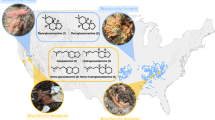Abstract
The Japanese giant looper, Ascotis selenaria cretacea, is a serious defoliator of tea gardens in Japan. GC-MS analysis of the virgin female extract confirmed the presence of (Z,Z)-6,9-cis-3,4-epoxynonadecadiene. This compound had attracted male moths in a previous random screening test using C17–C23 epoxydienes synthesized in a racemic form. Further GC and HPLC analyses with chiral columns showed that the natural pheromone was composed of 3S,4R and 3R,4S isomers in a ratio of 53:47, although the field evaluation revealed stronger activity of the pure 3R,4S epoxide than of other enantiomeric mixtures. This result indicates that the sexual communication system of this Japanese subspecies differs from that of the species in Israel, which is selectively attracted to an isomer with the opposite configuration. Interestingly, the 3S,4R epoxide attracted another geometric male, Alcis angulifera, in our field tests. (Z,Z,Z)-3,6-9-Nonadecatriene, a parent olefinic compound of the epoxy pheromone, was also identified in the gland extract of A. s. cretacea, but its effect on the attractive activity of the epoxide was not assured in field tests. The amount of the triene increased in the virgin female during photophase and also after decapitation. The epoxy component completely disappeared after decapitation, but could be increased by an injection of subesophageal ganglion extract. The data suggest that the triene is a biosynthetic precursor of the epoxide and that a neuropeptide hormone (PBAN) regulates the epoxydation.
Similar content being viewed by others
REFERENCES
ANDO, T., OHSAWA, H., UENO, T., KISHI, H., OKAMURA, Y., and HASHIMOTO, S. 1993. Hydrocarbons with a homoconjugated polyene system and their monoepoxy derivatives: Sex attractants of geometrid and noctuid moths distributed in Japan. J. Chem. Ecol. 19:787–798.
ANDO, T., KISHI, H., AKASHIO, N., QIN, X.-R., SAITO, N., ABE, H., and HASHIMOTO, S. 1995. Sex attractants of geometrid and noctuid moths: Chemical characterization and field test of monoepoxides of 6,9-dienes and related compounds. J. Chem. Ecol. 21:299–311.
ANDO, T., KASUGA, K., YAJIMA, Y., KATAOKA, H., and SUZUKI, A. 1996. Termination of sex pheromone production in mated females of the silkworm moth. Arch. Insect Biochem. Physiol. 31:207–218.
ARN, H., TÓTH, M., and PRIESNER, E. 1992. List of sex pheromones of Lepidoptera and related attractants. OILB-SROP/IOBC-WPRS, Secrétariat Général, F-84143 Montfavet, France, ISBN 92-9067-044-4, 179 pp.
BECKER, D., KIMMEL, T., CYJON, R., MOORE, I., WYSOKI, M., BESTMANN, H. J., PLATZ, H., ROTH, K., and VOSTROWSKY, O. 1983. (3Z,6Z,9Z)-3,6,9-Nonadecatriene—a component of the sex pheromonal system of the giant looper, Boarmia (Ascotis) selenaria, Schiffermüller (Lepidoptera: Geometridae). Tetrahedron Lett. 24:5505–5508.
BECKER, D., CYJON, R., COSSÉ, A., MOORE, I., KIMMEL, T., and WYSOKI, M. 1990. Identification and enantioselective synthesis of (Z,Z)-6,9-cis-(3S,4R)-epoxynonadecadiene, the major sex pheromone component of Boarmia selenaria. Tetrahedron Lett.. 31:4923–4926.
COSSÉ, A. A., CYJON, R., MOORE, I., WYSOKI, M., and BECKER, D. 1992. Sex pheromone components of the giant looper, Boarmia selenaria Schiff. (Lepidoptera: Geometridae): Identification, synthesis, electrophysiological evaluation, and behavioral activity. J. Chem. Ecol. 18:165–181.
KITAMURA, A., NAGASAWA, H., KATAOKA, H., INOUE, T., MATSUMOTO, S., ANDO, T., and SUZUKI, A. 1989. Amino aid sequence of pheromone-biosynthesis-activating neuropetide (PBAN) of the silkworm, Bombyx mori. Biochem. Biophys. Res. Commun. 163:520–526.
QIN, X.-R., ANDO, T., YAMAMOTO, M., YAMASHITA, M., KUSANO, K., and ABE, H. 1997. Resolution of pheromonal epoxydienes by chiral HPLC, stereochemistry of the separated enantiomers and their field evaluation. J. Chem. Ecol. 23:1403–1417.
RAINA, A. K. 1993. Neuroendocrine control of sex pheromone biosynthesis in Lepidoptera. Annu. Rev. Enlomol. 38:329–349.
RAINA, A. K., and KLUN, J. A. 1984. Brain factor control of sex pheromone production in the female corn earworm moth. Science 225:531–533.
WAKAMURA, S. 1992. Development in application of synthetic sex pheromone to pest management. Jpn. Pestic. Inform. 61:26–31.
Author information
Authors and Affiliations
Rights and permissions
About this article
Cite this article
Ando, T., Ohtani, K., Yamamoto, M. et al. Sex Pheromone of Japanese Giant Looper, Ascotis selenaria cretacea: Identification and Field Tests. J Chem Ecol 23, 2413–2423 (1997). https://doi.org/10.1023/B:JOEC.0000006683.58028.1e
Issue Date:
DOI: https://doi.org/10.1023/B:JOEC.0000006683.58028.1e




